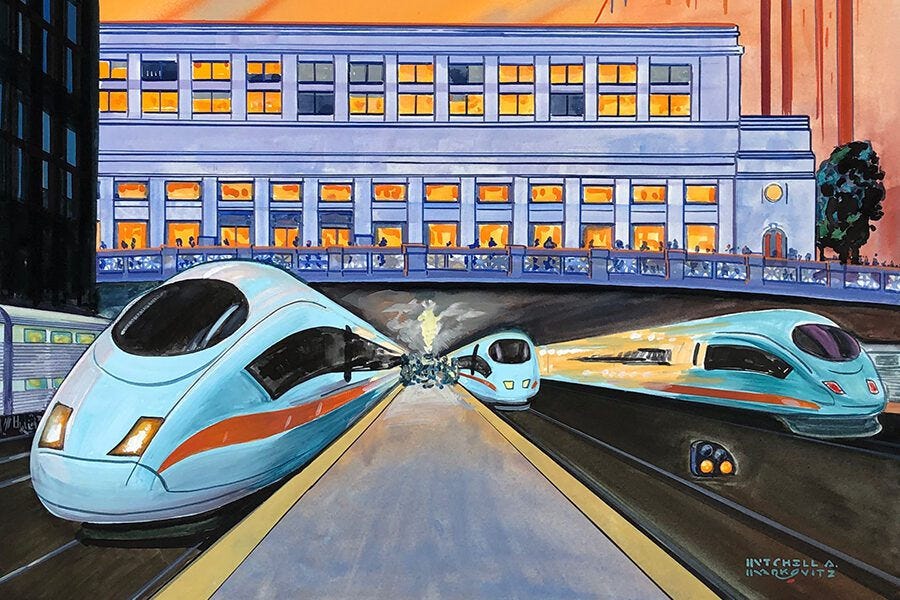Transportation is the backbone of America. In 1862, Congress passed the Pacific Railway Act to promote the construction of transcontinental railroads, cementing the U.S. as the industrial powerhouse we know today. Later, during the Cold War, Eisenhower enacted the Interstate Highway Act to strengthen the economy, establishing interstates across the country, increasing interconnectedness, and underpinning a six fold increase in our nation’s GDP.
Now, 70 years on, we are once again at a crossroads. While our transportation system used to be an inspiration to others, it now ranks dead last in virtually every single category. 45 percent of Americans lack access to transit, 40 percent of roads are in poor condition (despite increased spending), and the U.S. is only spending half of what is necessary on improvements.
Change is desperately needed. It’s time we welcome the next wage of manufacturing: High Speed Rail.
Not only does High Speed Rail revitalize the manufacturing sector by increasing demand for good paying manufacturing jobs, but the rail itself creates two profoundly positive effects for the American people.
High Speed Rail Reduces Congestion.
When looking at high-speed rail in France or China, one cannot help but feel disappointed by the U.S. The numbers speak for themselves: an 11-hour journey between New York and Chicago takes just 4.5 hours on China’s bullet trains.
Meanwhile, in the U.S., 47 percent of our interstates are congested, 47 million trips are canceled every year, and drivers lose two and a half work weeks sitting in congestion.
The lack of quality transit has left our roads congested, our cities polluted, and our economy strangled. As it stands, congestion will cost the economy $200 billion annually, and The American Society of Civil Engineers (ASCE) contextualizes that if the U.S. does not expand its infrastructure, the country will lose 10 trillion dollars in GDP and 3 million jobs by 2039.
Luckily, high-speed rail provides a comprehensive solution: Just one high-speed rail corridor can carry 400,000 people per day, providing 20 times the capacity of highways.
Added railway capacity translates to lower congestion. In the past, after the implementation of high speed rail, traffic fell by 8% in European countries. In the United States, a 4-9% reduction in traffic could reduce congestion by 50%, de-strangling our network of transportation.
High Speed Rail Improves Connectivity.
The U.S. is reorganizing itself around metropolitan clusters. The area spanned by Boston to Washington represents 20 percent of the GDP while LA accounts for 10 percent. Smaller American cities are increasingly cut off from the national agenda and are destined to be abandoned.
The segregation of wealth has led to an academic consensus revolving around rural poverty. Indeed, rural counties account for 84% of places struggling with persistent poverty and numerous health and education disparities.
However, by superseding the dilapidated transportation system we have with a new vibrant and efficient model, HSR can improve connectivity. In China, HSR improved connectivity nationally by 167 percent, allowing faster transportation cross-country, speedier shipment of goods and services, and spanning urbanization.
High-speed rail connects economically struggling rural areas to thriving urban centers, creating new opportunities for commerce in smaller cities and enabling workers to live in more affordable areas while commuting efficiently to metropolitan centers.
Beyond interconnectedness, by making it easier for workers to move in and out of cities, high-speed rail shifts demand for property from the higher-cost cities to the lower-cost suburbs and rural areas.
In Japan, high-speed rail cut land prices by 33 percent, reducing childhood poverty and increasing economic mobility by providing access to affordable housing.
It is for all these reasons that in Italy, by increasing transport accessibility for towns and cities along the HSR network, regional inequalities decreased 29 percent while per capita GDP increased 6.2 percent.
Costs of HSR: Inequality Fueler
Critics of HSR argue that because roads and airports connect all parts of the U.S., with rural areas being less likely to live in poverty than their urban counterparts, HSR is a sunk cost that’s fundamentally not necessary.
Empirically, HSR has been known to price out certain poorer workers, disconnecting cities served by fewer and slower trains—marginalizing entire regions of the country.
However, these empirics are cherry-picked and outdated. For instance, by connecting smaller cities like Bakersfield and Merced along the proposed California HSR line, there’s rising growth and ability for new opportunities of economic activity. More importantly, a comparative analysis is critical.
The initial cost of HSR might be high, but the cost of not investing is even higher. The American population will grow by 100 million in the coming decades, and generations of disinvestment are catching up to us. Decades of environmental disruption is slowly turning the corner, and long-term gains and sustainability is more important than ever. Ultimately, we must ask ourselves: Should we allow our global competitors to pull ahead of us permanently, or instead we invest in resilient infrastructure that will serve Americans for decades to come.






